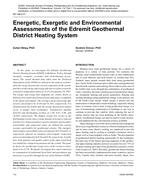Description
In this study, we investigate the Edremit Geothermal District Heating System (GDHS) in Balikesir, Turkey through energetic, exergetic, economic and environmental assessments. The actual thermal data taken from the Technical Department of the GDHS are utilized in the analysis to determine the exergy destructions in each component of the system, and the overall energy and exergy efficiencies of the system for a reference temperature taken as 13.4°C for January 20, 2007. The energy and exergy flow diagrams are clearly drawn to illustrate how much destructions/losses take place in addition to the inputs and outputs. The average energy and exergy efficiencies are found to be 32.69 and 54.26%, respectively. It is obtained from the results that the exergy destructions mainly occur in pumps, heat exchangers, transmission pipeline network and discharging sections as 1.66, 6.07, 8.04, and 29.94% respectively. The highest exergy loss occurs in the discharging section since a large amount of exergy is rejected into the river. Some parameters such as energetic and exergetic renewability and reinjection ratios are defined for various systems, particularly for geothermal systems. The energetic and exergetic renewability ratios are found to be 0.34 and 0.52, respectively whereas its energetic and exergetic reinjection ratios are determined to be 0.64 and 0.30, respectively. In addition, both quantity and quality values of the other fossil fuels are studied for comparison purposes for the system. The quality factor for geothermal exergy price of the system is calculated to be 0.178. We finally investigate how much reduction in consumption of traditional fossil fuels and greenhouse gas emissions is possible through the use of the Edremit GDHS.
Units: SI
Citation: ASHRAE Transactions, vol. 114, pt. 1, New York 2008
Product Details
- Published:
- 2008
- Number of Pages:
- 12
- File Size:
- 1 file , 1.5 MB
- Product Code(s):
- D-NY-08-017




